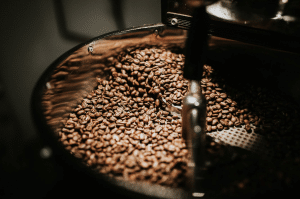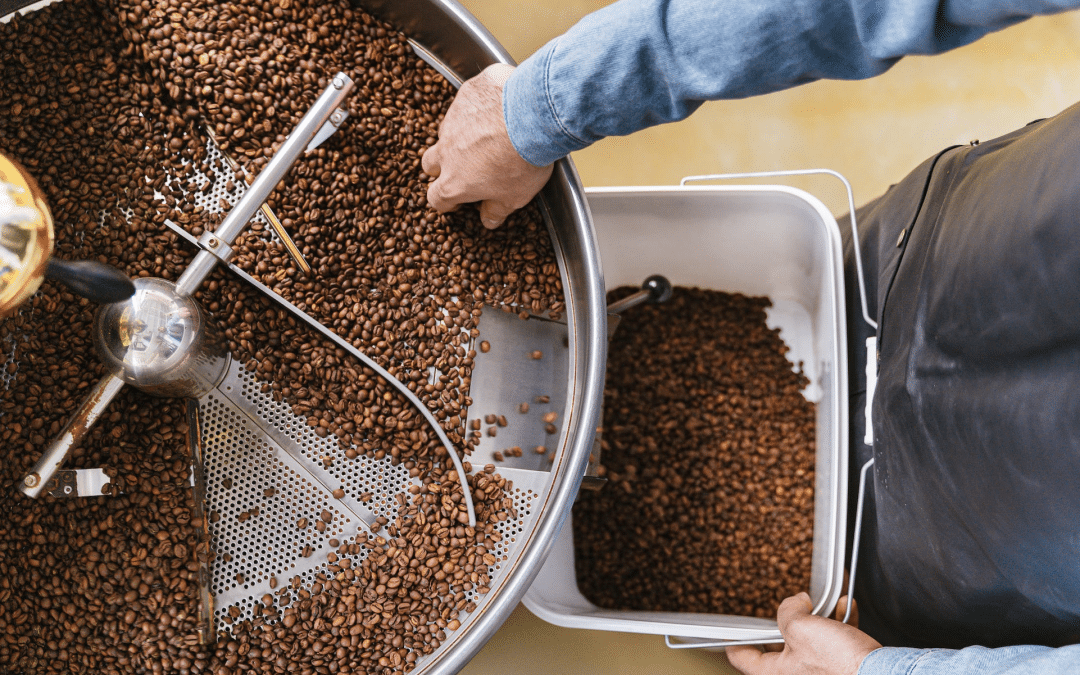Coffee roasting is so hot right now; it’s practically on fire! An essential part of the coffee-making process and a crucial step in getting that perfect cup of joe, coffee roasting has become an art form – with passionate connoisseurs worldwide devoted to finding the best way to do it. But what exactly does coffee roasting involve? What are its challenges and rewards? In this article, we’ll delve into the fascinating science behind coffee roasting, examining how it works and why it makes such a difference when enjoying our morning caffeine kick.
Roasting is all about bringing out the best qualities of each individual bean by applying heat at just the right time and intensity to unlock their full flavor potential. It takes skill, precision, experience – and plenty of practice – but once you’ve mastered your craft, there’s no better feeling than delivering a perfectly roasted batch of beans to appreciative customers who can enjoy them as they were meant to be enjoyed: fresh from the roast.
But before we go any further, let’s take a moment to explore some basics of coffee roasting. From understanding temperature profiles and recognizing specific aromas to learning which type of equipment is best for different roasting methods, these are all things you need to know to get great results every single time. So without further ado, let’s discover more about this intriguing topic together…
History Of Coffee Roasting
 Since antiquity, coffee has been a cherished commodity. From its earliest days in Ethiopia to today’s worldwide popularity, it results from careful and creative cultivation and roasting. Coffee roasting is an art form that, over time, has become more refined – though its principles remain essentially unchanged.
Since antiquity, coffee has been a cherished commodity. From its earliest days in Ethiopia to today’s worldwide popularity, it results from careful and creative cultivation and roasting. Coffee roasting is an art form that, over time, has become more refined – though its principles remain essentially unchanged.
The history of coffee roasting dates back to the 15th century when people roast green coffee beans directly on fire or in simple iron pans. Then, as technology advanced in the mid-19th century, drum roasters using indirect heat were developed. This method allowed for higher quality control and better flavor profiles by allowing even temperatures throughout the entire batch. As tastes changed and demand increased, further advances occurred, such as fluid bed air roasters, which use hot air instead of direct contact with a heating element.
Today, numerous methods are used commercially and at home, from traditional electric ovens to high-end precision machines capable of producing any desired profile according to individual taste preferences. Roastmasters can now produce light, medium, or dark roast styles depending on how long they expose the bean to heat, with variations occurring between batches due to differences in bean type or size and other factors like temperature and temperature humidity levels. Regardless of the method chosen, however, one thing remains constant; proper roasting technique yields superior-tasting coffee every time!
Different Types Of Roasting
Like the alchemist’s pursuit of gold, roasting coffee is an art form that requires skill and knowledge. It involves a delicate balance between heat, time, and air to bring out the complex flavor profiles of each bean. From light to dark roasts, several types of coffee roasts are used to create different flavors in our beloved morning beverage.
Light-roasted beans tend to have higher acidity levels with notes of citrus or berry. The color ranges from yellowish tan to light brown, resulting in a milder cup of coffee. Medium roasts generally have less acidity than their lighter counterparts but still possess some bright fruitiness. When roasting, these beans will appear medium brown and taste slightly sweeter than fair roast coffees.
The darkest type of roast is a French Roast or Italian Roast—it has minimal acidity due to its longer cooking times at high temperatures. This yields a rich smoky flavor and can be identified by its deep black coloration. Beyond these three primary categories, there is also espresso which uses extremely fine grinds, resulting in an intense yet smooth shot of caffeine heaven!
No matter your preference, careful preparation must go into every batch of roasted coffee beans for them to reach their full potential. Only when masterfully done can you truly experience all the aromas and tastes this magical elixir offers!
Understanding Roast Levels
The art of coffee roasting is a centuries-old tradition that has changed how we enjoy and experience coffee. Roasting in its simplest form requires heat to be applied to green beans, creating an alchemical transformation. Understanding roast levels can help unlock the full potential of your favorite coffees.
Let’s take a journey back in time to when the ancient Ethiopians first discovered coffee – they roasted their beans over open flames and stone griddles, imparting flavors unique to their region. Today, as most of us know it, modern coffee roasting occurs in large industrial machines known as drum roasters which apply direct heat from gas or electric elements. The length and temperature of the roast determine how dark or light the bean will become; lighter roasts tend to carry more complex fruit notes, while darker roasts provide a deeper body and smokier aromas.
At home, you can still achieve great results with some practice – all you need is patience, a good thermometer (for measuring internal bean temperatures), and a heating device such as an oven or skillet pan. You’ll also want to pay close attention to any visual cues, such as changes in color or smoke production during the process, so you don’t burn your precious beans! With each batch’s unique, you’ll find something new every time you experiment with different roast levels.
From savoring sweet honeycomb notes on light-roasted Tanzanian peaberry to digging into heavy chocolatey depths on Ethiopian Yirgacheffe, so many flavor profiles await exploration through understanding roast levels. It’s almost like participating in an exciting scientific discovery!
How To Prepare Beans For Roasting
Roasting coffee beans is like a dance between heat and time. It requires skill, attention to detail, and an understanding of the chemistry behind it all. As with any performance, preparation is critical for success in roasting coffee beans.
Before starting the roasting process, some essential steps should be taken to ensure quality results. Firstly, inspect your green (unroasted) coffee beans for defects or foreign objects. Throw away any defective beans before beginning the roast, ensuring only a high-quality final product. Additionally, ensure that the green beans are at room temperature so they can take in the maximum heat during roasting.
Next, weigh your desired quantity of green beans onto parchment paper or a metal colander to evenly spread them for even heating when exposed to high temperatures later on. This step also helps reduce smoke from burning trash due to moisture being removed from the bean during roasting. Lastly, preheat your desired roaster before adding your weighed-out beans inside; this allows more consistency in the overall roast by preventing uneven heat distribution caused by cold air being pulled in a while introducing raw materials.
Now that you have correctly prepared your green beans for the next roasting phase, you should feel confident knowing you’ve done everything possible to create delicious results! With an eye towards detail and careful consideration taken throughout each step leading up to now, you’ll soon be enjoying freshly roasted and flavorful cups of coffee made with love!
The Roasting Process
Coffee roasting is a process that has been around for centuries. Did you know that over 500 million cups of coffee are consumed daily? It’s no wonder that the roasting process plays such an essential role in our lives today.
So what exactly is it? Roasting is when green beans (coffee beans with no flavor or aroma) are heated up to bring out their natural oils and flavors. This involves temperatures of up to 480°F and can take 5-25 minutes depending on the desired outcome: light roast, medium roast, dark roast, etc. During this time, careful consideration must be paid to how quickly the temperature rises and falls to ensure we lock those delicious aromas in!
This complex process requires great skill from the roaster as they must always keep track of the temperature and duration. By doing so, they create one-of-a-kind blends that tantalize our taste buds like nothing else! The end result will always depend upon the individual’s preferences. Still, ultimately it’s through expertly roasted coffee beans that we get those perfect cupfuls of caffeinated goodness each morning.
Cooling The Roasted Coffee
The cooling of the roasted coffee is like a phoenix descending from its ashes. Emerging from the flames, it is transformed and ready to be enjoyed by all who savor it.
This process has been around for centuries, changing little over time regarding technique or execution. After roasting beans, they must cool quickly to capture their flavor and aroma at their peak. This can be accomplished through various methods, such as air-cooling or water quenching, depending on the kind of roast you aim for.
Cooling allows the bean’s essential oils and aromas to develop fully before grinding and brewing; with this step, the potential flavors of your cup may reach fruition. To ensure that each sip contains enough depth and complexity, an effective cooling system is vital.
In essence, cooling is the final stage of transformation from raw beans to delicious cups – one which will bring joy with every sip. It should be done carefully and thoughtfully if you want your brews to reflect the full potential of those excellent beans!
Storing Roasted Coffee
Now that the roasted coffee has been cooled, it’s time to store it. Proper storage of freshly-roasted coffee is key for maintaining its flavor and aroma. Here’s what you need to know about storing roasted coffee.
When storing your beans, ensure they’re in an airtight container away from light and moisture – this will help keep them fresh. You can put a few different types of containers to use here: glass jars, plastic bags with valves, or even vacuum-sealed packets are all great options. When putting the beans into one of these containers, try not to fill it more than two-thirds full – otherwise, there won’t be enough room left over for expansion when gasses escape during release.
For maximum freshness, only grind enough beans before brewing, so you don’t have to keep unused grounds around too long. If you find yourself with extra beans left over after grinding, place them back into their original package or another suitable container. Doing this should maintain their quality for up to three months in optimal conditions!
Storing roasted coffee correctly takes little effort. Still, it makes all the difference in preserving its flavor and aromas for more extended periods. So next time you buy some freshly-roasted coffee, remember the importance of proper storage to get the most out of your brews!
What Is The Most Popular Coffee Roast?
Light roast coffees have a milder taste and are the most popular. The two main categories are medium-light and medium-dark roast, each with unique characteristics. Light roasts have more acidity and delicate flavors, while darker roasts produce deeper aromas and a fuller body.
So why is one degree of roast more popular than another? It really boils down to personal preference; most people prefer light roasts for their subtlety and complexity, while others might enjoy the boldness of a dark roast. Ultimately, deciding which type best suits your needs is up to you! At the end of the day, whichever kind of coffee you choose should make you happy – that’s all that matters.

